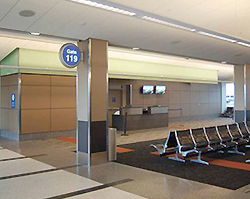I felt the need to write this article after a recent cross-country trip, and I’m pretty sure many of you can relate to my experience. At a newer, modern airport, I was waiting to board a connecting flight, and everything appeared to be going as planned until the departure time suddenly changed on the monitor – a one hour delay.
However, I never learned the reason for the delay, because the gate attendant making the announcement either had the mic down her throat – or, more likely – the paging system was defective. Speech intelligibility was poor to non-existent.
This can’t be, I thought. A modern airport certainly must have a paging system utilizing the latest technology, properly designed and installed to provide maximum intelligibility. We all need to “hear and understand” the announcements, right? After all, this is kind of the point, and unfortunately, it was a point completely missed by this system.
There can be several reasons for poor intelligibility with a paging system. In this case, the system was most plagued by bad loudspeakers combined with poor placement, and I’m sure “Mr. Budget” had negative impact as well, as it often does in systems of this nature. I wonder how many people miss their flights daily due to a poor paging system? One would think the amount of money wasted on compensating for missed flights would justify the cost of insuring every airport paging system sound do what it’s supposed to do: deliver intelligible audio to everyone in the facility.
Many audio professionals believe distributed audio cannot sound good. And in fact, it’s never going to sound as good as a finely tuned PA, but it also doesn’t need to sound like a badly tuned AM radio. If a distributed system is designed and budgeted properly, there is absolutely no reason for poor intelligibility or background music quality.
Distributed audio products have improved much over the past 15 or so years, because many manufacturers realized that distributed audio is big business. For example, there used to be only a few manufacturers offering ceiling loudspeakers, and now, just about everyone in the loudspeaker business has jumped on the bandwagon. Keep in mind that a major brand name on a loudspeaker doesn’t at all mean it provides the appropriate and necessary performance. Quality ceiling products take time to perfect.
THE WEAKEST LINK
While choosing proper loudspeakers for a distributed application is essential for good results, if you’re feeding these drivers limited audio signal and power, they still will not perform properly. The system will only be as good as its weakest link, therefore, every component in the chain – microphone(s), mixer, power amplifiers, step-up power transformers, wire gauge, step-down transformers and loudspeakers – must deliver good frequency bandwidth.
Another significant problem with distributed systems is the power amplifier side of the equation. Unfortunately, some installers lack understanding as to how to properly utilize power amplifiers for distributed applications. As with loudspeakers, most power amp manufacturers now offer products for distributed applications. I’m often asked about the differences between a standard two-channel power amp and a 70.7-volt or 100-volt power amp. Besides connectors and security features, there’s not much discrepancy.















